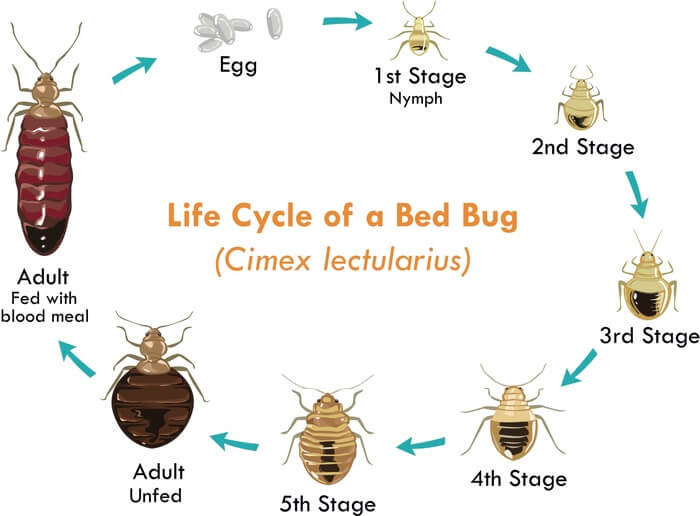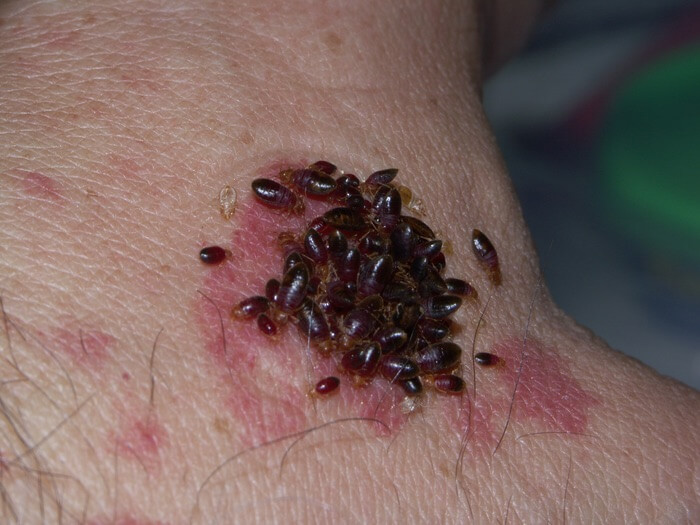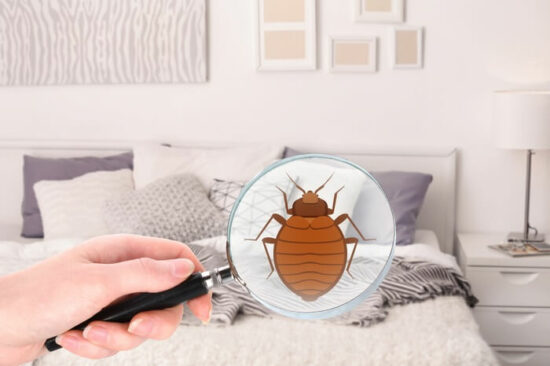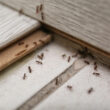Identifying baby bed bugs is a very useful skill to have if you’re committed to keeping your home pest-free. These little creatures are a sign of an infestation, and recognizing them will allow you to act quickly when it comes to removing them.
In this guide you’ll learn all about bed bug nymphs and what they look like. Trust us, you’ll want to read it closely!
Table of contents
What Do Baby Bed Bugs Look Like?
Bed bugs are one of the most hated pests in the world! With their penchant for feeding on human blood in the dead of night and their ability to multiply rapidly, these parasitic pests can be a nightmare to handle.
While most people assume that it’s the adults you have to worry about, baby bed bugs are just as bad! Also known as nymphs, they look strikingly similar to their more mature counterparts (making them hard to tell apart).
So what do baby bed bugs look like?
If you were to put a nymph and an adult side by side, the primary differences are size and color. Beyond that, freshly hatched bed bugs have many of the same features.
Baby bed bugs have an oval-shaped body that’s slightly flattened. They’re segmented as well and sport a much larger lower section. Six tiny legs and two lengthy antennae round off their physical features.
Quick Tip: Interestingly enough, metamorphosis is not a part of the bed bug’s life cycle. Unlike other common household pests, there’s no larval or pupation stage.
Baby bed bugs do go through some changes as they age, but those transformations are not as extreme as the evolutions you see in other bugs. After hatching, nymphs go through five stages of development before reaching adulthood.
During those stages, the bug will molt, grow, and change color. But as a whole, their physical appearance and biology remain largely the same.
How Big Are They?
Contrary to popular belief, you don’t need to whip out the magnifying glass to see baby bed bugs. They’re perfectly visible with the naked eye.
After hatching, bed bug nymphs are typically 1.5 millimeters big. For some perspective, that’s about the size of a grain of rice! They are tiny and can be challenging to spot, but they’re still identifiable without any additional equipment.

The size of adult bed bugs isn’t massive either. However, the size difference between baby bed bugs and adult insects is pretty significant. When fully grown, developed bed bugs can reach lengths of about five to seven millimeters.
That’s about a quarter of an inch in size. Many compare them to the size of an apple seed. By comparison, the growth spurt these bugs go through is extreme.
Quick Tip: On average, baby bed bugs grow about half a millimeter between each growth stage. To accommodate that growth, these bugs must shed their old skin and make way for a harder exoskeleton to develop.
Do Baby Bed Bugs Bite?
One big misconception about bed bug nymphs is that they don’t bite. But make no mistake, baby bed bugs are just as hungry as adults! They won’t hesitate to bite you in your sleep and feed on your blood.
These insects are considered to be parasitic. They feed exclusively on blood and rely on other living organisms to survive. The only difference between bed bugs and other known parasites is that these pests live on the outside of your body!
While they’re capable of feeding on any mammal’s blood, bed bugs seem to prefer humans. They’re attracted to many biological signatures. However, entomologists believe that body warmth and the carbon dioxide you exhale draw them in most.
Whatever the case may be, baby bed bugs must find a food source if they want to move onto the next developmental stage. Because they feed on nothing but blood, they must bite to survive!
Unlike adult bed bugs, nymphs can’t go a year without food. They only last a few weeks at most. That means feeding (and biting) is a top priority for them after hatching.

Feeding provides the nutrients they need to grow. It facilitates the maturation process. Not only that, but the blood they eat is largely responsible for the physical changes that occur when they reach adulthood. More on that soon!
Baby bed bug bites look nearly identical to those from an adult insect. There’s not much size difference involved, as babies use the same mechanics to bite. They utilize two straw-like appendages to gain access to your blood (yum).
The first component is responsible for breaking the skin and boring an access hole to your bloodstream. It also injects saliva that numbs the site. Bed bug saliva has a natural anesthetic that allows them to feed undetected.
The second appendage sucks up the blood for feeding. Most baby bed bugs feed for only a few minutes at a time. Despite the numbing agent, your body’s immune system reacts and releases histamines.
Quick Tip: Bed bug nymphs are primarily nocturnal like adults. However, these young insects will feed as often as they need to move onto the next growth stage. That means they’ll typically extend this daily feeding window a little bit.
The Color Of Baby Bed Bugs
Here’s where spotting baby bed bugs gets difficult. When they first hatch, bed bugs are mostly white. They match the color of the egg and usually have a slight tinge of cream or yellow to them.
That means if you’re using white sheets on your bed, baby bed bugs blend in effortlessly!
Thankfully, they do become more visible after feeding. You see, nymphs have much thinner exoskeletons than adults. They’re almost translucent, so you can often see their latest meal through their body.
Interestingly enough, baby bed bugs start to develop their signature brown color the more they eat. Digested blood nutrients are responsible for the insect’s reddish-brown hue. You can see how the nutrients change body color through different growth stages.
At first, the otherwise white nymphs may have a small dot of brown in the center of the abdomen. That dot continues to grow until it overtakes most of the lower section. Then, the exoskeleton begins to darken as it toughens up.
By the time they’re full-fledged adults, the blood nutrients turn the white exoskeleton into a rich coppery brown.
How Fast Can They Move?
Bed bugs aren’t the fastest creatures in the insect kingdom. When compared to roaches or other household pests, they move much slower.
That’s because these pests do not need to crawl ultra fast. They’re not like other predatory bugs. Instead of getting into fights with others, bed bugs would much rather stay in hiding!
They’re all about staying in the shadows and finding a discreet place to hide.
In the event that they do encounter trouble, bed bugs can crawl to get away. But, their tiny little legs make them pretty slow by comparison.
And baby bed bugs are even slower! Their exoskeletons are not as developed as those of adults. As a result, the legs are weaker. On top of all that, they’re smaller.
Bed bug nymphs can try their hardest to get away from trouble. But even if the legs move at breakneck speeds, these young pests can’t achieve much speed at all.
The Best Ways To Look For Them
Finding baby bed bugs can be challenging due to their small size and discrete nature. However, it’s not impossible.
The trick is understanding where these insects live and what they leave behind.
If you wake up with itchy bites, it’s imperative to do your due diligence and search for these pests. The presence of bed bug nymphs means that there’s a larger population of bugs in your home. Spotting babies will help you determine the right course of action to prevent bed bugs from spreading fast, resulting in large-scale infestations from taking over your home.
So, how do you find these buggers? Here are some tips to guide you.
Look For Molted Shells
Remember how we said that baby bed bugs go through five stages of development? Between those stages, it sheds its skin to make way for additional growth.
Oftentimes, you can find the remnants of the molting process around your home. They look like tiny replicas of the bug. However, the shell will likely crumble under any pressure.
Quick Tip: Adults do not shed. These bugs stop growing once they reach maturity, so molting is unnecessary.
If you spot any empty exoskeletons, they’re likely from a growing bed bug nymph. You can find shells just about anywhere, but they will likely be concentrated near food sources.
Search For Eggs
Another telltale sign of bed bug nymphs is eggs.
Mature females can lay upwards of 500 eggs in their lifetime. Furthermore, they don’t have to mate recently to start the process. As long as she’s had a partner in the past, she’s capable of laying eggs.
As mentioned earlier, eggs are about a millimeter long. They’re bright white during the gestation period. But once the bug emerges, they dry up and turn yellow or brown.
You can often find fresh eggs around growing populations. Whether you find fresh eggs or hatched ones, there’s a good chance that bed bug nymphs are nearby.
Check Common Hiding Spots
The most reliable best way to find baby bed bugs is to search the areas where they like to live the most. These pests live in massive groups. Many in the pest control industry refer to bed bug homes as harborages.
Harborages are typically near food sources. They like to stay nearby so that they can strike at night. Because human blood is their most available source of food, the first place you should look is in your bed.
Baby bed bugs tend to reside in bed frames, under mattresses, or in folds of upholstery. Any piece of bedroom furniture is fair game.
Many homeowners find them in nightstands, picture frames, and even electrical switchplates.
Quick Tip: Focus your search on areas that you don’t interact with much. Spots that stay dark are a great place to search, too.
Inspect Cracks & Voids
Don’t forget to look in cracks and holes. Many assume that baby bed bugs only live on soft surfaces. That’s not the case!
These insects take advantage of any discrete spot they can find. Cracks in furniture, baseboards, and decorative trim are some of the best places to call home!
Give those areas a look over to ensure that you don’t miss any bed bug nymphs (or adults of course).
Utilize Detector Traps
If you suspect that you have a bed bug issue, try using a detector trap.
These tiny devices are readily available at most stores. They look kind of like roach motels. However, they’re specifically made to attract bed bugs.
The thing that makes detector traps unique is that they prevent escape. Sticky floors keep any bugs that enter from leaving. Meanwhile, a small window on the top or side lets you see the bugs clearly.
Traps are a fantastic way to get physical proof of a baby bed bug problem. Stick a few traps around your bedroom furniture and wait. If they’re there, you can catch them and know for sure.
Use Visibility Tools
If you’re still having trouble finding bed bug nymphs, consider using some visibility tools for assistance.
A simple magnifying glass can work wonders! Use it on those common harborage spots we went over earlier. The magnifying glass will help you get an up-close and personal view.
Blacklights may help as well. Nymphs and adults have a small amount of phosphor in the exoskeleton. The phosphors absorb UV light and reflect visible light.
When you shine invisible blacklight at a baby bed bug, it should light up with a fluorescent finish.
Quick Tip: This technique is more effective on adult bed bugs. The exoskeletons of babies are thinner and more delicate. However, you should be able to spot babies in the later growth stages.
Can Bed Bug Nymphs Lay Eggs?
Fortunately, baby bed bugs cannot lay eggs. Only mature females are capable of laying eggs. That said, it doesn’t take long to reach adulthood!
The average lifespan for a bed bug is about four to six months. The exact growth rate of a nymph depends on many external factors. However, most go through the five stages of development in about five weeks!
At that point, adults are able to mate and lay eggs.
Other Insects That Look Like Them
These pests are just one of many insects that could be in your home.
While they’re distinct in their own right, it’s not uncommon for people to misidentify them. There are several pests that look similar to bed bug nymphs.
Some of the most common are:
- Carpet beetles
- Spider beetles
- Lice
- Fleas
- Mites
- Ticks
- Baby cockroaches
All of those insects have a similar oval-shaped body. Some are also flat, which leads to cases of mistaken identity.
This is why it’s important to familiarize yourself with the appearance of adult bed bugs. Remember, bed bug nymphs have the same body shape and structure as adults. Knowing those subtle physical characteristics will help you differentiate these bugs from others in your home.
Final Thoughts
Baby bed bugs aren’t terribly difficult to identify if you know what to look for. Fortunately, they don’t differ too much from adults (other than size and color).
We hope you now feel prepared to identify bed bug nymphs so you can take the appropriate action. The more you know, the less of a problem they’ll be!


